Alkaline proteases are the most important group of extremoenzymes which have a wide array of applications in various industries such as detergent, food, pharmaceutical, leather and silk. For the purpose of maximum alkaline protease production, response surface methodology was performed using Bacillus licheniformis. The sources used were glucose as carbon source, peptone as nitrogen source, sodium phosphate as phosphorus source and zinc sulfate and magnesium sulfate as micronutrients salt solution; pH and temperature selected for optimization. Response surface methodology central composite deigns, involving 26 full factorial half fractions, designed 53 experiments with different combination using six sources and analysis of data was done by SPSS 16. The multiple linear regression model equation was articulated by the coefficient of the determination R2 and statistical significance of the variables were checked by p (<0.05) value, if lesser the p value then higher the significant of the subsequent coefficient. Importance of the regression coefficient was tested by t test. Applying statistical analysis multiple linear regression using quadric equation shows that the effect of carbon (C), micronutrient salt solutions (M), phosphorous (P2), carbon and phosphorous (CP), carbon and micronutrient salt solutions (CM), carbon and temperature (CT), nitrogen and micronutrient salt solutions (NM), nitrogen and temperature (NT), micronutrient salt solutions and pH (MpH), were given significant results and enhance the production of alkaline proteases by Bacillus licheniformis.
Alkaline Protease, Response Surface Methodology, Bacillus licheniformis
© The Author(s) 2014. Open Access. This article is distributed under the terms of the Creative Commons Attribution 4.0 International License which permits unrestricted use, sharing, distribution, and reproduction in any medium, provided you give appropriate credit to the original author(s) and the source, provide a link to the Creative Commons license, and indicate if changes were made.


